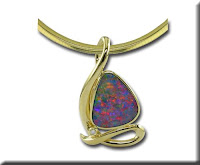18 interesting Opal facts
 |
| Opal Doublet Slide |
- The name opal comes from the Latin «opalus», which in turn is coming from the Greek «opallios», itself coming from the Sanskrit « upala » meaning precious stone.
- Opal ranges from clear through white, gray, red, orange, yellow, green, blue, magenta, rose, pink, slate, olive, brown, and black. Of these hues, the reds against black are the most rare, whereas white and greens are the most common.
- Archaeologist Louis Leakey found six-thousand year old opal adornments in a cave in Kenya.
- Opals can express every color in the visible spectrum.
- In late 2008, NASA announced that it had discovered opal deposits on Mars.
- The ancient Greeks believed opal could give to the wearer the power of foresight.
- Precious opal consists of spheres of silica of fairly regular size, packed into close-packed planes which are stacked together with characteristic dimensions of several hundred nm.
- The Romans revered opal as the symbol of hope and purity, and believed it could protect from disease.
- Fire opals are transparent to translucent opals with warm body colors yellow, orange, orange-yellow or red and they do not usually show any play-of-color, although occasionally a stone will exhibit bright green flashes.
- Eastern people regarded it as the symbol of truth. The Ancient Arabs believed it came from heaven, and that it acquired the play of color from flashes of lightning.
- The most famous source of fire opals is the state of Querétaro in Mexico and these opals are commonly called Mexican fire opals.
- In the Middle Ages, opal was thought to be beneficial for eyesight, some people even believed it could render the wearer invisible.
- Harlequin opal Opal is classified in three primary types according to its body color supporting the play of colors. These types are black, white and transparent.
- Australia produces around 97% of the world's opal.
- Two notable producers of synthetic opal are the companies Kyocera and Inamori of Japan. Most so-called synthetics, however, are more correctly termed "imitation opal", as they contain substances not found in natural opal (e.g., plastic stabilizers).
- Some types of opal do not display play of color. Among those there is the bulk of orange «fire», a green variety resembling chrysoprase called prase opal, and a blue green variety found in Peru.
- Opal is considered the birthstone for people born in October or under the sign of Libra and the star stone for people born under Scorpio.
- In the Middle Ages, opal was considered a stone that could provide great luck because it was believed to possess all the virtues of each gemstone whose color was represented in the color spectrum of the opal.
